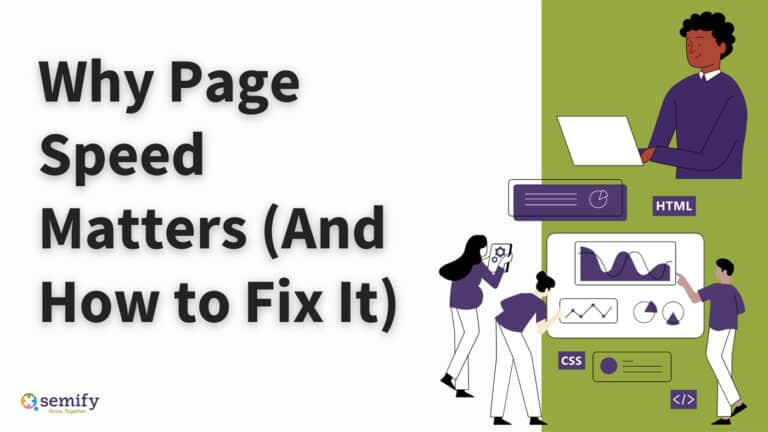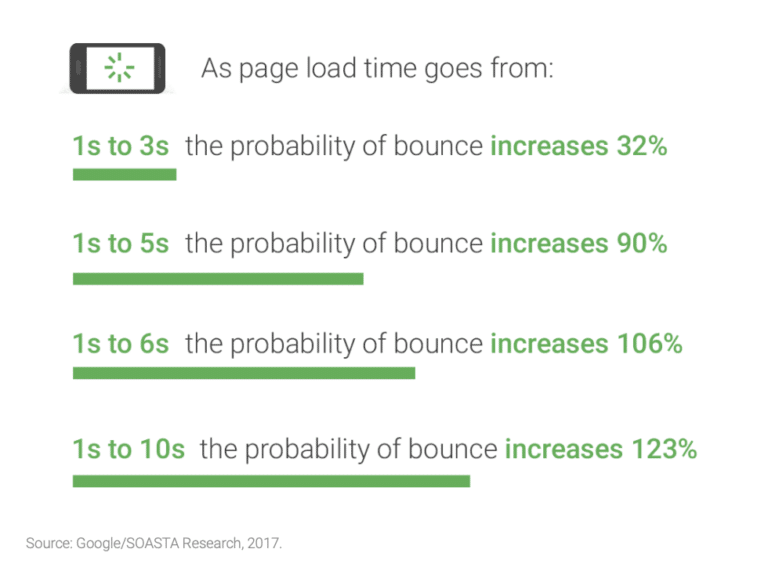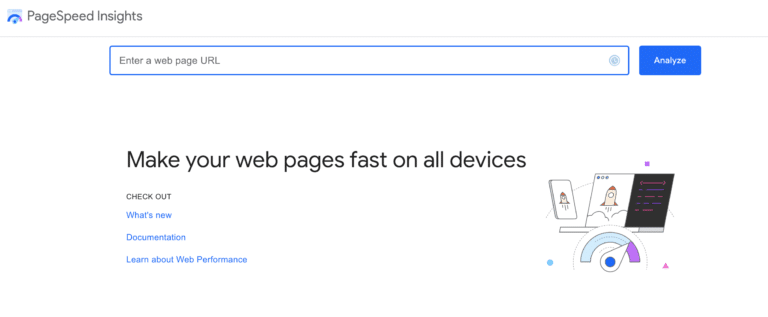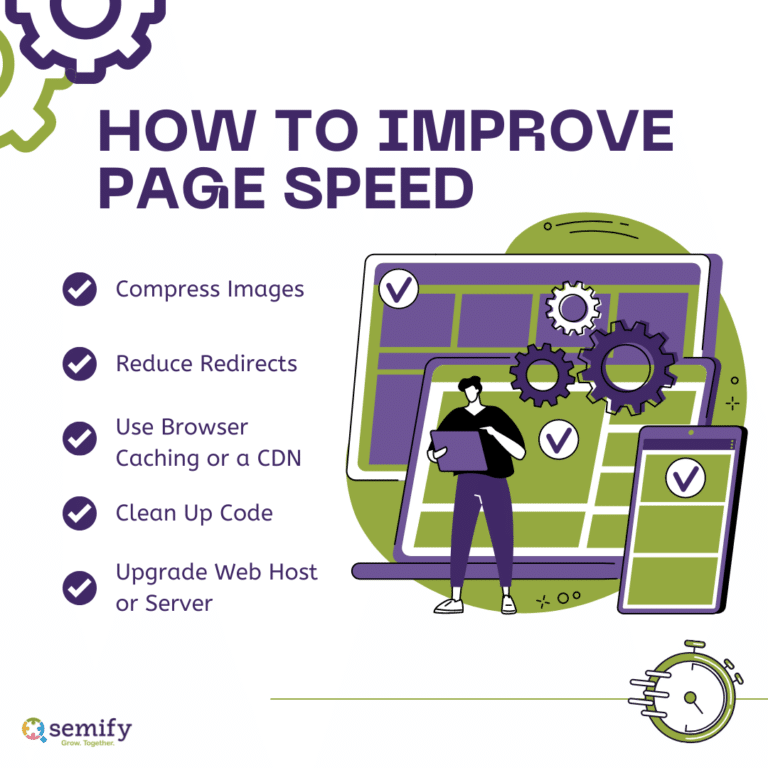
In a time when we want immediate answers, the speed of a website matters more than ever. If a web visitor is unable to get the information they need within a matter of only a few seconds, the unfortunate reality is that they’re going to give up and look elsewhere. In fact, Neil Patel tells us that 40% of people abandon a site that takes more than 3 seconds to load.
But sales aren’t the only thing you’ll lose when your website is sluggish. Whether you’re looking to improve your own rankings or to take your clients to the next level, you’ll be held back by a slow-loading site – or a singular, slow-loading page.
Since many business owners may not realize the gravity of their stagnant sites, agency owners need to take action when developing an SEO strategy. Page speed matters so much that it should be addressed before you fully launch into link-building or blog content creation. But why is it so important? And what can you do to fix it? Let’s talk about it.
What is Page Speed?
Site speed, as you may already know, simply measures the amount of time it takes for a website to load for users. Site speed is actually based on an average of multiple instances of page speed throughout a given website. It’s really a sample view of how quickly your site loads as a whole.
That means that the term “page speed” isn’t interchangeable with site speed. Instead, this is the base measurement that tells us how long it takes for all of the elements on a given page – like the text and visuals – to completely load.
Page speed can be expressed in a couple of different ways. Page load time is the most accessible, as it’s easy to see how long it takes for 100% of the content to be displayed on a given web page. It’s also possible to measure page speed in what’s known as “time to first byte,” which describes the time it takes for a web user’s browser to receive the very first byte of information about a web page from the web server.
There are a few other ways that search engines can measure the speed of a page, including First Meaningful Paint (FMP) and Largest Contentful Paint (LCP). FMP refers to how long it takes for the most impactful content to appear on the screen and allows users to interact with the most important element on the page. LCP, a metric to which we were introduced during Google’s Page Experience update, measures the amount of time it takes for a page’s largest element to fully load. (Both of these metrics apply to the most important or largest element “above the fold,” which is the part of the web page that’s visible without a user having to scroll.)
While all of these methods for measuring page speed matter, focusing on page load time is seen as the most comprehensive. If your entire page loads quickly, your FMP and LCP rates will usually be impressive, too. That said, page load time alone won’t always give you the full picture of whether users really have to wait that long to interact with your content.
Why Does Page Speed Matter For SEO?
We know what page speed is, but why does page speed matter so much? Think of your clients’ web visitors like Veruca Salt – they don’t care, they want it NOW.
Patience may be a virtue, but it’s not one that many of us have (especially online!). Just think of the last time you tried to search for vital information, only to encounter a spinning wheel or a server that couldn’t handle your request. You probably let out a huff and hit the “back” button immediately. Your client’s customers will be quick to do the same.
According to Google research:

But, as Backlinko points out, the average website took over 10 seconds to load fully on desktop in 2019. On mobile, it’s even worse! The average site took 27.3 seconds to fully load on smartphone screens that same year. And while those figures might have improved since then (thanks in part due to Google’s emphasis on page speed), most websites are likely still too slow to satisfy today’s shoppers.
With so much choice available to us and a wealth of information at our fingertips, we’re simply not going to wait around in most cases. For hard-to-get concert tickets or limited designer drops, maybe. But on the average day, we’ll just pivot and look elsewhere for what we need. Data shows that conversion rates drop by anywhere from 2% to 7% for every second a page’s load time is delayed.
Keep in mind, however, that a slow-loading site has both immediate and long-term consequences for your clients. Not only will they alienate potential customers, but they could also have trouble improving their SEO or their PPC ad performance. Because both site and page speed are now considered to be ranking factors for Google Search and Google Ads, a lagging website can tank your client’s ability to rank – or to appear in their desired ad space.
When Google released its Core Web Vitals a couple of years ago, it became clear that one of their primary focuses was on the user experience. Loading time, along with interactivity delays and visual stability, is now a critical component in how websites are evaluated.
That being said, speed isn’t exactly a new ranking factor. As Search Engine Journal points out, Google’s algorithm prioritized speedy websites as far back as 2010. While it wasn’t until 2018 that mobile speed and mobile-first indexing came to the forefront, Google’s decision to view fast sites more favorably all comes back to providing the best possible results for end users. (Note: Google has said that the newest iteration, the page experience update, has essentially replaced its former speed-based ranking factors to reduce redundancies.)
SEO isn’t the only place where site speed matters. It can impact your PPC campaigns, as well. Site speed can affect your Google Ads Quality Score, which influences both ad placement and cost per click (CPC). A client with a slower site may end up paying more to run their ads – and those ads might not be as visible as they could be. Since this can adversely affect customer satisfaction, paying attention to page speed can pay dividends for your agency.
Although relevance is still more important than page speed in both organic and paid search, we know that the loading pace of a page can help break the tie between two otherwise equal options.
How Do I Measure Page Speed For My Clients?
Now that you know why page speed matters, you need to know how to identify a slow site. One of the easiest ways to do that is to turn to Google’s PageSpeed Insights or to run another page speed test.

Google’s page speed insights tool allows you to enter a URL and assess how quickly it loads for both desktop and mobile users. The page speed insights platform will break down specific aspects of page speed (like the Core Web Vitals and other performance issues) so you can easily identify what needs to be improved. Google even provides recommendations to guide you.
Google also has a Mobile Speed Score, which was introduced in 2018 as part of Google Ads. This is evaluated a bit differently from other site speed measurements, as it’s a 10-point scale that evaluates the relationship between page speed and an ad’s potential conversion rate. You can view the mobile speed score for a given page as part of your Google Ads campaign.
There are a number of other page speed tests available, such as Pingdom, WebPageTest, and more. While Google’s version is seen as the gold standard, there are other platforms that may be a bit more user-friendly for beginners or that provide additional features that may be helpful in managing your campaigns.
At Semify, we also make it easy for our partners to access the page speed insights they need. In the first month of a campaign, we provide a comprehensive report that includes the fully loaded site time. We also include the site’s initial response time in our agency dashboard so you can access this data at any time.
Of course, simply knowing how fast or slow a site is won’t be enough. You also need to know how to speed up a site to improve responsiveness and overall results.
How Can I Improve Page Speed For Better SEO?
Say that you’ve entered your client’s information into Google’s Page Speed Insights tool or another page speed test and you don’t like the results. Now that you know why page speed matters, you need to know how to speed up a site to improve SEO or PPC campaign results in the future.
Fortunately, there are many potential ways to improve page speed and the overall user experience. As your white label SEO agency guide, we’re outlining a few suggestions for you below.

Compress Images
When you’re first trying to figure out how to speed up a site, you need to look at the components that take the most time to load. Chances are good that a page’s visual elements are slowing its speed down. That said, web pages need images and other visual media to engage readers and even help them retain information.
Rather than get rid of these elements altogether, we suggest that you compress them. Image compression will reduce the size of the file without compromising on quality. That means your images and videos will still look sharp and captivating without taking what feels like years to load.
Depending on the content management system (CMS) your client uses for their website, there may be easy-to-use plugins that will automatically compress anything uploaded to their image library. There are also a number of free tools and software programs that can help you compress images before they’re uploaded to the client’s site.
Web visitors won’t ever be able to tell that the images are compressed by looking at them, but they’ll notice a huge difference in how quickly a page will load as a result. This is a simple step that can add tremendous value for your clients.
Reduce Redirects
Redirects can be useful, in some cases, but they can also slow down a website considerably. Both temporary and permanent redirects are meant to guide visitors to the right destination. If it takes too long to bring them there, however, they may abandon their journey entirely.
Each time one page redirects to another, the web user has to wait for what’s called the HTTP request/response cycle to finish. That can add seconds onto the final page’s loading time. That may not sound like a big deal, but we know that every millisecond counts.
Although some redirects may be necessary, others can be removed or avoided entirely. It’s good practice to audit the client’s website to eliminate non-vital redirects or amend redirects to reduce “hops.” Remember, the fastest way to get anywhere is via a straight line!
Use Browser Caching or a CDN
A browser cache is like a visitor’s individual memory bank. Without caching, your browser will experience every website like it’s 50 First Dates. Every time you visit a familiar website, it’ll behave like it’s the very first time. But when you use caching, your browser will remember and pull up the site’s elements a lot more quickly. Although this won’t improve page speed for first-time visitors, it can make a big difference for those who have visited the website more than once.
A content delivery network (CDN) provides another way to speed up a website. A CDN will essentially store copies of your website within different data centers. When a visitor pulls up the website, the site will be distributed to the visitor from the server located closest to them. With less distance to travel, the site’s information will load more quickly for the user.
Clean Up Code
With back-end coding, there can be too much of a good thing. HTML, CSS, JavaScript, and other kinds of code do take up a lot of space. Although a lot of this code may be necessary for ensuring the site runs smoothly, some of it may be extraneous. Extra code can slow down a site’s speed, so it’s beneficial to minify unused or duplicated code.
There are a number of plugins and other tools you can use to identify excessive code and clean it up. That said, any white label SEO agency would recommend you hire a qualified web developer to avoid any mistakes.
Upgrade Web Host or Server
It’s also possible that your client’s site functions well under ideal circumstances… but that their host or server is holding them back. If your client’s site is on a shared server or their hosting service can’t provide the necessary capacity, it may be time to talk to them about upgrading.
If the host or server is behind the site’s slow speeds, it won’t matter how much you optimize. You’ll still run into issues with the site’s loading time until you fix the root cause. Remind them that it pays to invest in a server or web hosting service that can handle their traffic! While $10 a month for hosting may sound like a bargain, they may end up missing out on a lot of sales due to slow speeds.
With Page Speed, Slow and Steady Doesn’t Win the Race
Certain aspects of SEO require a lot of patience. But web visitors don’t have time to waste. Addressing sluggish site speeds can markedly improve user experience, bounce rate, conversions, and search rankings – so don’t sleep on the need for speed. To learn more about how we can help set your clients up for success with our white label SEO program, get in touch with our team today.